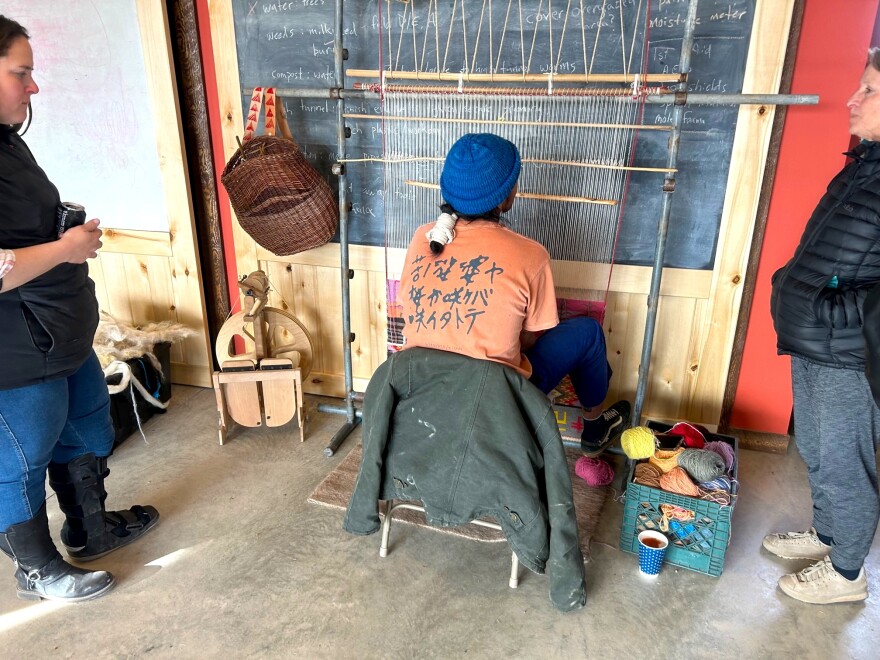Navajo-Churro sheep, a breed considered sacred in Navajo beliefs, are a source of community and artistic expression for a group of herders and weavers in the Four Corners region.
At Fozzie’s Farm in Lewis, Colorado, Tyrrell Tapaha wove the beginnings of a Navajo tapestry with a loom. He used wool from flocks of Churro sheep that he dyed brilliant shades of lavender, red, pink, and orange.
“In the summer times, I'll pull 16-hour days weaving. It'll be like 3 in the morning… This is my whole life, this is how I make my income,” said Tapaha.
Tapaha, a member of the Navajo Nation, is part of a group of apprentice weavers in the Four Corners region who are herding Churro sheep.
In the late 1500s, Spanish colonists brought the Churro to the region, and Navajo people came to depend on Churro sheep for the breed’s meat and uniquely durable wool.
But Churro sheep almost became extinct – twice. During the Long Walk of the Navajo in 1863, the U.S. military forced the tribe to relocate as part of a campaign of ethnic cleansing. And then During the Dust Bowl in the 1930s, U.S. government livestock reduction policies decimated the breed again.
Roy Kady is a master fiber artist and sheep herder from Goat Springs, Arizona. He leads the group of apprentices, including Tapaha. Kady spoke to around 20 community members at Fozzie’s Farm about the history of Churro sheep.
He and his apprentices are at Fozzie’s as part of a partnership with Montezuma Land Conservancy, a land trust that manages the farm. MLC allowed Kady and his apprentices to graze their sheep at the farm – in return, the weaver provided education on the breed to the general public.
“Not all of the Navajos went on the Long Walk,” said Kady. “And the ones that didn't were the ones that helped save this breed of sheep. They took it with them across the San Juan river, hid high in the mountains, and some down in Canyon de Chelly.”
Tapaha described the responsibility he feels to keep the tradition of sheep herding and fiber weaving alive.
“We don't own it,” he said. “It's knowledge that we should pass on since we don't have ties to it in that way… You don't have to practice this. You don't have to live this way, but just as long as you know.”

For lunch, the weavers roasted a sheep they slaughtered earlier in the morning. Attendees of the sheep celebration gathered around the grill, watching the fire hiss and sputter as the mutton cooked. Above the flames, wisps of grayish-yellow clouds slid over the farm and nearby Ute Mountain.
Kady discusses the importance of sheep herding to generations of his family.
“I’m filling these big shoes that my mother wore as an agro-pastoralist,” he said. “I continue those traditions with the next generations to come. In caring for the land, in turn, the land takes care of you.”
Kady said that today, younger generations don’t need to weave rugs and textiles solely to sell products, as was common during the trading post era.
“That was imposed on us as a part of colonization because this was being woven for the trading post, for their sole purpose to sell it to the tourists and to profit from three or four times fold,” he said. “Now, you're the artist; now, you're in control of your own artistry, your interpretation of what you want to design and to weave.”
Tapaha is one of Roy Kady’s many fiber-weaving apprentices. He says he’s grateful for Kady’s leadership.
“There's always a teacher and a student, and I think that dynamic has always been positively enforced in my life,” Tapaha said.
“I was once them, their age, and I was once taking that unknown path and wondering where my life would be,” Kady said. “Continuing that journey in my life into old age, it makes me happy. It fulfills me.”

The legacy of Navajo-Churro sheep herding and weaving will live on with community celebrations similar to this one.
They’re happening all across the Navajo Nation, most recently at the Dził Ditł’ooí School of Empowerment, Action and Perseverance (DEAP) in Navajo, New Mexico, where Kady visited last week to give demonstrations to students on weaving.
Kady and his apprentices continue to educate the public about spinning and dyeing Churro wool, and the history that lives in between each thread.




